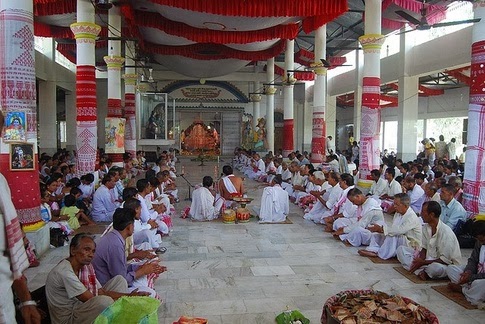Assamese cinema is in doldrums. To my knowledge, none of the Assamese films in the last few years have made profits. It has become critical that we understand the reasons and do the needful to try to revive Assamese cinema.
In order for Art to survive, it needs patrons.
This is more so when it comes to commercial cinema. Commercial cinema needs much more than cinema lovers. It needs patrons at various stages of the film from making, distribution to exhibition. In other words, commercial cinema needs an eco-system to survive and flourish. The eco-system that is tightly bound by commercial and other interests. The eco-system of commercial cinema comprises the Financiers, Producers, Production, Creative, Distributors, Actors, Exhibitors (cinema halls) and Audience (Patrons).
Each of these elements of the eco-system has to profit from the act of making, distributing and exhibiting the film. The motivation comes from the commerce of the trade of making films. We have to understand each of these elements in detail, to analyze and find a solution for the future of Assamese cinema.
I don't have extensive experience in the Assamese film industry to opine on each of the elements of the eco-system. This article is primarily from my experience of producing, distributing and promoting India's first martial arts comedy - an Assamese feature film - Local Kung Fu.
Poor Dated Content
Bordoloi Trophy was extremely popular and Gauhati stadium used to be packed until television came and increased the expectation from a football match. This is the same psychology affecting Assamese Cinema. The quality of Bollywood, Hollywood and South Indian Film has improved with time. They have become accessible to Assamese audience like any Assamese film. Perhaps more accessible than Assamese cinema. So it is obvious that Assamese film has to compete with all kinds of content easily available and accessible today. It is a pure economics of demand and supply, where Assamese cinema is failing to create demand because of poor quality of content – both creatively and technically. .
As recent as last week, an Assamese film was released with mono sound. Can you believe it? Cinematography, Choreography, Editing, VFX, Sound Design, Art Design, Make-up & Styling - all these departments have to open to current trends, technology and young talent. We have educated and experienced Assamese talent in Mumbai, Delhi and Chennai who have to be given the responsibility to create cinema at par with Bollywood.
Cinema is Business. Distributors are Wholesalers. Cinema Halls are Retailers.
Assam does not have a single distributor whose primary business interest is regional Assamese cinema – a distributor who distributes Bollywood and other films, but has either emotional or sentimental interest towards Assamese cinema. A cinema hall is dependent on the distributors for films. A distributor has the upper hand in deciding for the cinema halls. But Assam does not have a distributor (patron), who feels strongly for Assamese cinema.
As a result of which, Assamese films today just get one show, that too in a non profitable time-slot. In a city like Dibrugarh or Jorhat, where there are multiple cinema halls, Assamese cinema is lucky to get one show and one theatre. Distributors would openly suggest to the producer to release in one cinema hall in one city / town. There are 69 cinema halls considering the defense halls in Assam, and it is unfortunate that it is a great achievement to get 17-18 halls for an Assamese cinema.
A recent release only got 7 cinema halls. 7 cinema halls multiplied by 7 shows in a week is 49 shows. If 200 people come in all the shows, we will have an audience of 9800. If we take an average of Rs. 25 as the share of the producer in a ticket, the net collection for the film would be 2,45,000. This makes the business of films a loss making proposition from the start.
Assamese cinema lovers and patrons need to invest in an exclusive distribution channel hiring the best talents, which would have the power to dictate terms with the exhibitors. The channel should get all the Bollywood mega hits to distribute in Assam. A box office hit benefits all the cinema halls, more than the distributor himself. Once the exhibitors make money out of these releases, the channel would get the upper hand to release an Assamese cinema asking for the best shows on the best dates.
I am planning to start a distribution business in Assam with the next horror film of the famous Ramsay Entertainment - Neighbours. Check the trailer here. I am in touch with producers to buy the rights for 'Jackpot', 'Dedh Ishqiya', 'Gulab Gang'. I am looking forward for investments. There is risk, but there are handsome gains as well.
Cinema halls too have a critical role to play. Most of the cinema hall owners are not Assamese by language and by community. It is not that they should not own cinema halls. But the fact is that they will naturally have a lesser interest or passion for Assamese cinema. Without Assamese people coming out to open cinema halls with all modern projection and sound equipments, Assamese cinema will have a tough time getting screened in the first place.
The cinema hall business is a profitable business if the business is done like it should be done keeping the consumers in mind.
For instance, Assam is hot, humid and poor. Assam does not have variety in terms of cinema options. Assam does not have entertainment options. Low cost cinema halls with AC and dolby 5.1 sound with 2 or more screens with less than 80 seats may be a profitable option. It is not necessary that these halls only run Assamese cinema. Bollywood releases a new movie almost every week. Bollywood has many hit cinemas that consumers would like to watch on big screens. These halls can also be used for music functions, plays and quiz/debate competitions.
Missing Stardom. Missing Aspirations.
 Assamese cinema does not the essential STAR attraction. The actors and actresses are not bigger than life. People do not aspire to be like them, or to follow them. Most of the actors and actresses work for a living like any normal Assamese. Assamese cinema has failed to give them the pedestal of respect, fame and money, that any actor or actress gets in other cinema industry.
Assamese cinema does not the essential STAR attraction. The actors and actresses are not bigger than life. People do not aspire to be like them, or to follow them. Most of the actors and actresses work for a living like any normal Assamese. Assamese cinema has failed to give them the pedestal of respect, fame and money, that any actor or actress gets in other cinema industry.One of our famous actresses is a lawyer, which means she is accessible and available in the high court every other day for the common people. This undeniably takes away the exclusivity and star attraction for her, in the minds of the cinema audience.
When we were kids and Assamese cinema was doing well, Nipon Goswami, Biju Phukan, Brajen Borah, Purabi Sarma etc. were larger than life. People used to flock to have a look at them. We used to wait for a film with our favourite actors and actresses. That is no longer the case. We now instead have Bollywood stars that we follow. The media and the film fraternity has to understand this essential ingredient for a successful cinema industry. We have to lift our actors and actress to a pedestal where they become stars. Exclusivity has to be created. The remuneration has to increase many folds so that they don't have to have alternate careers. They should not get into mobile theatres, but for special appearances.
Actors and Actresses also have a role to play. They have to maintain their glamour quotient by being fit and slim, and by being good social citizens.
Alternate Distribution Channels
The world of cinema is not limited to theatres alone. With Internet and technology, films can be distributed in multiple ways. The audience is also scattered across the globe. Assamese cinema can be made available to the Assamese population staying outside Assam and India through the use of technology.
We have options like BigFlix and Netflix for online streaming of movies. We have online stores like Flipkart and Amazon for selling of DVDs. We have the DTH channels where movies can be distributed with a fee (Airtel Movies, Tatasky Showcase etc). We have upcoming technologies like Lukup, which can distribute content to any device like a television, mobile or the computer. We have the option of social media and YouTube to create awareness of the films. We can even put the whole movie on YouTube and earn revenues through advertising.
I should also mention that all the local clubs and auditoriums in various parts of the state of Assam could be instrumental in bringing Assamese cinema to those towns and villages where there are no cinema halls. All we really need is a DVD player, a projector, a good sound system and curtains to make the auditorium dark enough for viewing cinema. The producer and the auditorium authorities can share the revenue equally, helping both the parties to earn handsome revenues.
Cinema is an integral part of a culture. If cinema is not aspirational and in demand, the culture tends to get stagnated and diluted. It is of immense importance all of us - proud Assamese - should come forward and help the cause of Assamese cinema with a vengeance.



